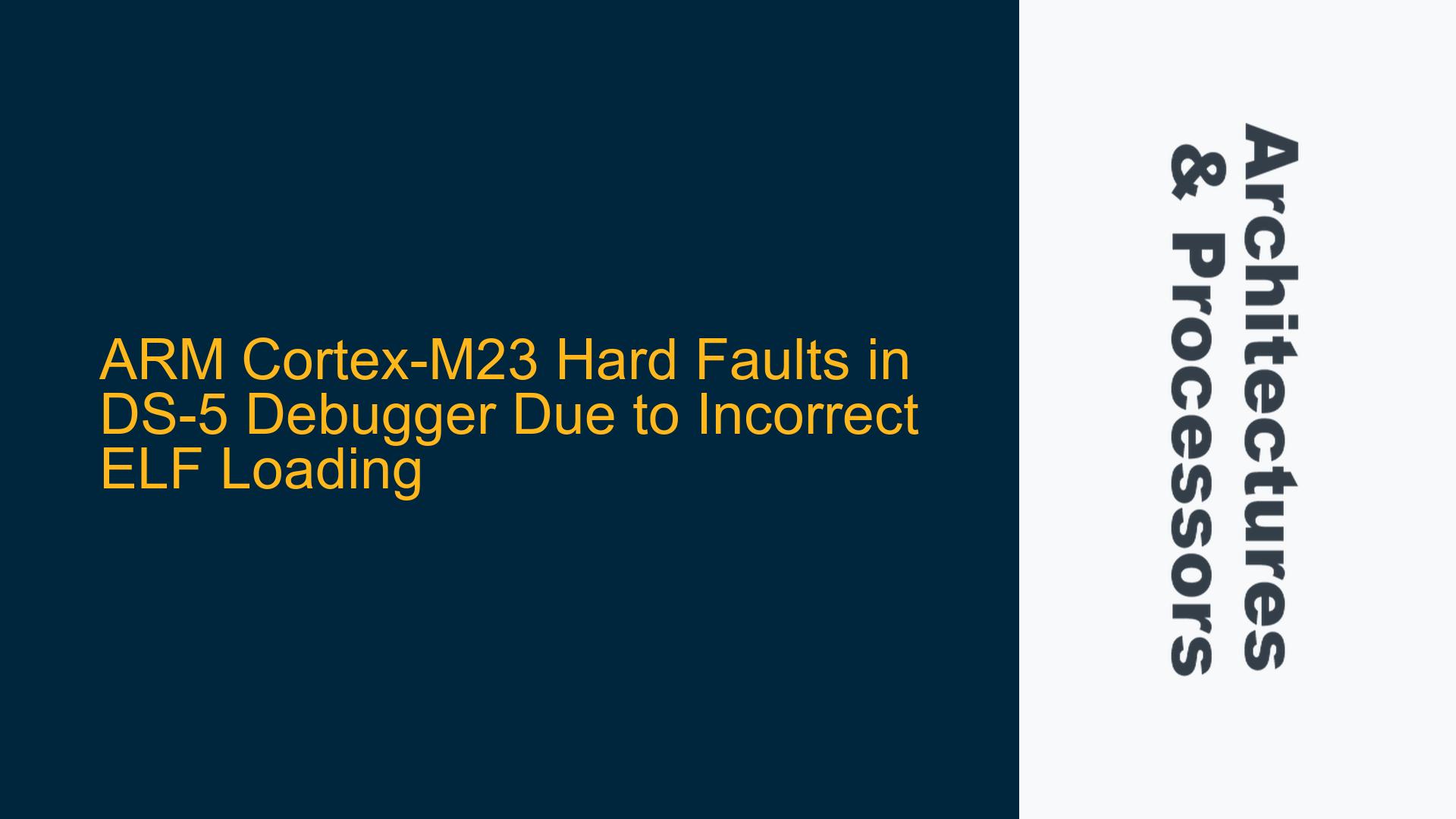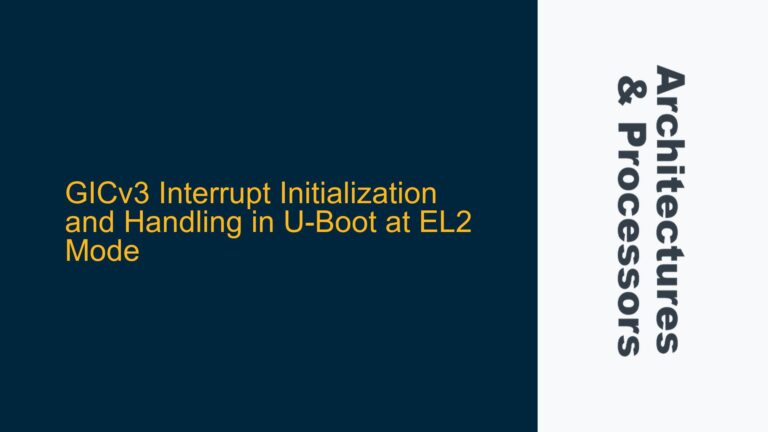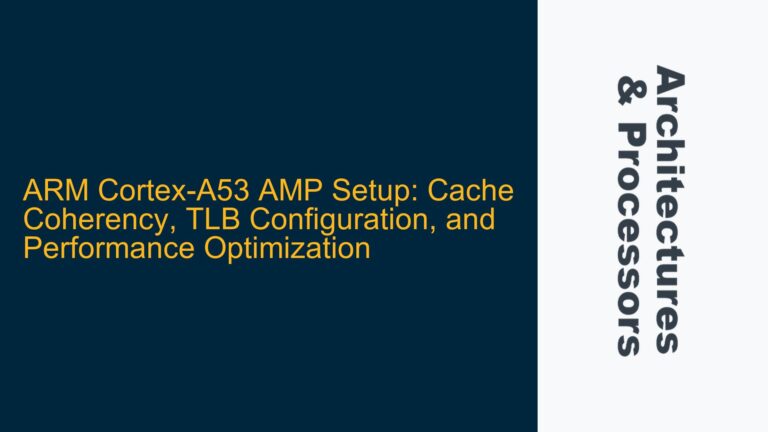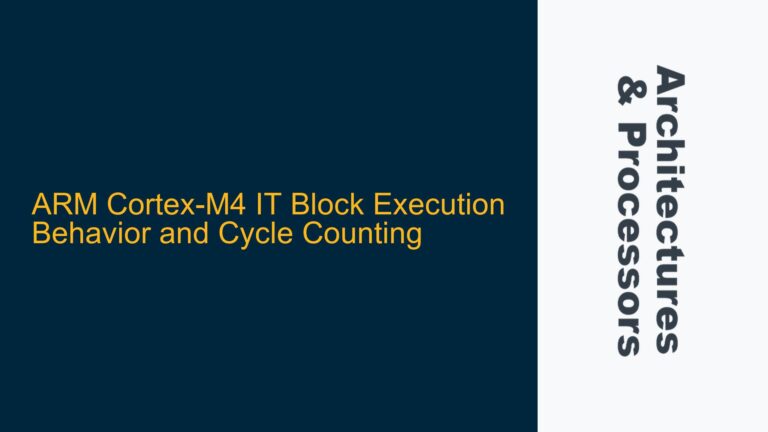ARM Cortex-M23 Hard Faults During libc_init_array Execution in DS-5 Debugger
When debugging an ARM Cortex-M23 application using the DS-5 Debugger, a hard fault occurs during the execution of the libc_init_array function. Specifically, the fault happens when the BLX R3 instruction is executed, and the value in the R3 register is 0xCFDFDFDF. This value points to an invalid memory location, causing a memory read failure. The issue is unique to the DS-5 Debugger, as the same application runs without issues when using the ARM Fast Models’ Model Debugger. The root cause lies in how the DS-5 Debugger handles the loading of ELF segments, specifically the difference between Virtual Memory Address (VMA) and Load Memory Address (LMA).
DS-5 Debugger ELF Segment Loading Behavior
The DS-5 Debugger, unlike other debuggers such as the ARM Fast Models’ Model Debugger, loads ELF segments directly to their Virtual Memory Address (VMA) equivalents instead of their Load Memory Address (LMA). This behavior can lead to incorrect memory mapping, especially in systems where the VMA and LMA are not the same. In the case of the Cortex-M23 TrustZone example, the libc_init_array function relies on specific memory addresses being correctly populated with initialization data. When the DS-5 Debugger loads the ELF segments to the VMA instead of the LMA, the initialization data is not placed in the expected memory location, leading to the R3 register containing an invalid address (0xCFDFDFDF). This results in a hard fault when the BLX R3 instruction attempts to jump to this invalid address.
The difference in behavior between the DS-5 Debugger and the Model Debugger can be attributed to the way each tool handles ELF file loading. The Model Debugger correctly loads the ELF segments to their LMA, ensuring that the initialization data is placed in the correct memory location. This allows the libc_init_array function to execute without issues. However, the DS-5 Debugger’s default behavior of loading segments to the VMA disrupts this process, leading to the observed hard fault.
Impact of Incorrect ELF Loading on Cortex-M23 TrustZone Example
The Cortex-M23 TrustZone example relies on the correct initialization of data in specific memory regions to function properly. The libc_init_array function is responsible for calling constructors for global C++ objects and other initialization routines. These constructors and routines are stored in the .init_array section of the ELF file, which must be placed in the correct memory location for the application to execute correctly. When the DS-5 Debugger loads the ELF segments to the VMA instead of the LMA, the .init_array section is not placed in the expected memory location. As a result, the R3 register contains an invalid address, leading to a hard fault when the BLX R3 instruction is executed.
The issue is further compounded by the fact that the DS-5 Debugger does not provide a clear indication of the incorrect memory mapping. The debugger simply reports a memory read failure when attempting to access the invalid address, making it difficult to diagnose the root cause of the problem. This lack of diagnostic information can lead to significant delays in identifying and resolving the issue, especially for developers who are not familiar with the nuances of ELF file loading and memory mapping in ARM architectures.
Resolving ELF Loading Issues in DS-5 Debugger
To resolve the issue of incorrect ELF loading in the DS-5 Debugger, the set elf load-segments-at-p_paddr on command can be used. This command forces the DS-5 Debugger to load ELF segments to their Load Memory Address (LMA) instead of their Virtual Memory Address (VMA). By ensuring that the ELF segments are loaded to the correct memory location, the libc_init_array function can execute without issues, and the hard fault is avoided.
The set elf load-segments-at-p_paddr on command should be executed before loading the ELF file in the DS-5 Debugger. This ensures that the debugger correctly maps the ELF segments to their LMA, preventing the R3 register from containing an invalid address. Once the command is executed, the application can be loaded and debugged as usual, with the libc_init_array function executing correctly and the hard fault being resolved.
In addition to using the set elf load-segments-at-p_paddr on command, developers should also ensure that their ELF files are correctly configured with the appropriate VMA and LMA values. This can be done by carefully reviewing the linker script used to generate the ELF file and ensuring that the memory regions are correctly defined. By taking these steps, developers can avoid issues related to incorrect ELF loading and ensure that their applications execute correctly when using the DS-5 Debugger.
Detailed Explanation of ELF File Loading in ARM Debuggers
ELF (Executable and Linkable Format) files are commonly used in embedded systems to store executable code, data, and debugging information. When an ELF file is loaded into a debugger, the debugger must correctly map the ELF segments to the appropriate memory locations in the target system. This mapping is determined by the Virtual Memory Address (VMA) and Load Memory Address (LMA) values specified in the ELF file.
The VMA is the address at which a segment is expected to be located during execution, while the LMA is the address at which the segment is actually loaded into memory. In many cases, the VMA and LMA are the same, and the debugger can simply load the segment to the specified address. However, in some cases, the VMA and LMA may differ, requiring the debugger to load the segment to the LMA and then relocate it to the VMA during execution.
The DS-5 Debugger’s default behavior of loading ELF segments to the VMA instead of the LMA can cause issues in systems where the VMA and LMA are not the same. This is particularly problematic in systems that rely on specific memory mappings for initialization routines, such as the Cortex-M23 TrustZone example. By forcing the DS-5 Debugger to load ELF segments to their LMA using the set elf load-segments-at-p_paddr on command, developers can ensure that the segments are correctly mapped to the appropriate memory locations, preventing issues such as hard faults during initialization.
Best Practices for Debugging ARM Cortex-M23 Applications
When debugging ARM Cortex-M23 applications, it is important to be aware of the potential issues related to ELF file loading and memory mapping. Developers should carefully review the linker script used to generate the ELF file and ensure that the VMA and LMA values are correctly defined. Additionally, developers should be familiar with the behavior of the debugger they are using and understand how it handles ELF file loading.
In the case of the DS-5 Debugger, developers should use the set elf load-segments-at-p_paddr on command to ensure that ELF segments are loaded to their LMA. This can prevent issues such as hard faults during initialization and ensure that the application executes correctly. Developers should also be aware of the potential for differences in behavior between different debuggers and be prepared to adjust their debugging approach accordingly.
By following these best practices, developers can avoid common pitfalls related to ELF file loading and memory mapping and ensure that their ARM Cortex-M23 applications execute correctly when using the DS-5 Debugger. This will help to reduce debugging time and improve the overall reliability of the application.
Conclusion
The issue of hard faults during the execution of the libc_init_array function in the DS-5 Debugger is caused by the debugger’s default behavior of loading ELF segments to their Virtual Memory Address (VMA) instead of their Load Memory Address (LMA). This behavior can lead to incorrect memory mapping, resulting in invalid addresses being loaded into registers such as R3 and causing hard faults when instructions such as BLX R3 are executed.
To resolve this issue, developers should use the set elf load-segments-at-p_paddr on command to force the DS-5 Debugger to load ELF segments to their LMA. This ensures that the segments are correctly mapped to the appropriate memory locations, preventing hard faults and ensuring that the application executes correctly. Additionally, developers should carefully review their linker scripts and ensure that the VMA and LMA values are correctly defined to avoid issues related to incorrect ELF loading.
By following these steps and best practices, developers can effectively debug ARM Cortex-M23 applications using the DS-5 Debugger and avoid common pitfalls related to ELF file loading and memory mapping. This will help to improve the reliability and performance of their applications and reduce the time spent on debugging and troubleshooting.






